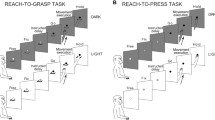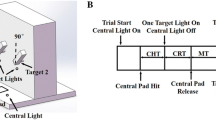Abstract
The activity of cells in primary motor cortex (MI) and dorsal premotor cortex (PMd) were compared during reaching movements in a reaction-time (RT) task, without prior instructions, which required precise control of limb posture before and after movement. MI neurons typically showed strong, directionally tuned activity prior to and during movement as well as large gradations of tonic activity while holding the limb over different targets. The directionality of their movementand posture-related activity was generally similar. Proximal-arm muscles behaved similarly. This is consistent with a role for MI in the moment-to-moment control of motor output, including both movement and actively maintained postures, and suggests a common functional relation for MI cells to both aspects of motor behavior. In contrast, PMd cells were generally more phasic, frequently emitting only strong bursts of activity confined mainly to the behavioral reaction time before movement onset. PMd tonic activity during different postures was generally weaker than in MI, and showed a much more variable relation with their movement-related directional tuning. These results imply that the major contribution of PMd to this RT task occurred prior to the onset of movement itself, consistent with a role for PMd in the selection and planning of visually guided movements. Furthermore, the nature of the relative contribution of PMd to movement versus actively maintained postures appears to be fundamentally different from that in MI. Finally, there was a continuous gradient of changes in responses across the rostrocaudal extent of the precentral gyrus, with no abrupt transition in response properties between PMd and MI.
Similar content being viewed by others
References
Barbas H, Pandya DN (1987) Architecture and frontal cortical connections of the premotor cortex (area 6) in the rhesus monkey. J Comp Neurol 256: 211–228
Bauswein E, Fromm C, Werner W, Ziemann U (1991) Phasic and tonic responses of premotor and primary motor cortex neurons to torque changes. Exp Brain Res 86: 303–310
Bullock D, Grossberg S, Guenther FH (1993) A self-organizing neural model of motor equivalent reaching and tool use by a multijoint arm. J Cogn Neurosci 5: 408–435
Caminiti R, Johnson PB, Galli C, Ferraina S, Burnod Y (1991) Making arm movements within different parts of space: the premotor and motor cortical representation of a coordinate system for reaching to visual targets. J Neurosci 11: 1182–1197
Crammond DJ, Kalaska JF (1994) Modulation of preparatory neuronal activity in dorsal premotor cortex due to stimulus-response compatibility. J Neurophysiol 71: 1281–1284
di Pellegrino G, Wise SP (1991) A neurophysiological comparison of three distinct regions of the primate frontal lobe. Brain 114: 951–978
di Pellegrino G, Wise SP (1993) Visuospatial versus visuomotor activity in the premotor and prefrontal cortex of a primate. J Neurosci 13: 1227–1243
Dum RP, Strick PL (1991) The origin of corticospinal projections from the premotor areas in the frontal lobe. J Neurosci 11: 667–689
Feldman AG, Levin MF (1995) Positional frames of reference in motor control: the origin and use. Behav Brain Sci 18: 723–804
Fetz EE (1992) Are movement parameters recognizably encoded in the activity of single neurons? Behav Brain Sci 15: 679–690
Freund H-J, Hummelsheim H (1985) Lesions of premotor cortex in man. Brain 108: 697–733
Fu Q-G, Suarez JI, Ebner TJ (1993) Neuronal specification of direction and distance during reaching movements in the superior precentral premotor area and primary motor cortex of monkeys. J Neurophysiol 70: 2097–2116
Fu Q-G, Flament D, Coltz JD, Ebner TJ (1995) Temporal encoding of movement kinematics in the discharge of primary motor and premotor neurons. J Neurophysiol 73: 836–854
Galea MP, Darian-Smith I (1994) Multiple corticospinal neuron populations in the macaque monkey are specified by their unique cortical origins, spinal terminations, and connections. Cereb Cortex 4: 166–194
Georgopoulos AP (1991) Higher order motor control. Annu Rev Neurosci 14: 361–377
Georgopoulos AP, Caminiti R, Kalaska JF (1984) Static spatial effects in motor cortex and area 5: quantitative relations in a two-dimensional space. Exp Brain Res 54: 446–454
Georgopoulos AP, Kettner RE, Schwartz AB (1988) Primate motor cortex and free arm movements to visual targets in three-dimensional space. II. Coding of the direction of movement by a neuronal population. J Neurosci 8: 2928–2937
Georgopoulos AP, Crutcher MD, Schwartz AB (1989) Cognitive spatial-motor processes. 3. Motor cortical prediction of movement direction during an instructed delay period. Exp Brain Res 75: 183–194
Georgopoulos AP, Taira M, Lukashin A (1993) Cognitive neurophysiology of the motor cortex. Science 260: 47–52
Halsband U, Freund H-J (1990) Premotor cortex and conditional motor learning in man. Brain 113: 207–222
Halsband U, Passingham RE (1985) Premotor cortex and the conditions for movement in monkeys (Macaco fascicularis). Behav Brain Res 18: 269–277
Halsband U, Ito N, Tanji J, Freund H-J (1993) The role of premotor cortex and the supplementary motor area in the temporal control of movement in man. Brain 116: 243–266
He S-Q, Dum RP, Strick PL (1993) Topographic organization of corticospinal projections from the frontal lobe — motor areas on the lateral surface of the hemisphere. J Neurosci 13:952–980
Hocherman S, Wise SP (1991) Effects of hand movement path on motor cortical activity in awake, behaving rhesus monkeys. Exp Brain Res 83: 285–302
Hogan N (1984) An organizing principle for a class of voluntary movements. J Neurosci 4: 2745–2754
Holsapple JW, Preston JB, Strick PL (1991) The origin of thalamic inputs to the “hand” representation in the primary motor cortex. J Neurosci 11: 2644–2654
Johnson PB, Ferraina S, Caminiti R (1993) Cortical networks for visual reaching. Exp Brain Res 97: 361–365
Kalaska JF, Crammond DJ (1992) Cerebral cortical mechanisms of reaching movements. Science 255: 1517–1523
Kalaska JF, Drew T (1993) Motor cortex and visuomotor behavior. Exerc Sport Sci Rev 21: 397–436
Kalaska JF, Cohen DAD, Hyde ML, Prud'homme M (1989) A comparison of movement direction-related versus load direction-related activity in primate motor cortex, using a two-dimensional reaching task. J Neurosci 9: 2080–2102
Kalaska JF, Cohen DAD, Prud'homme M, Hyde ML (1990) Parietal area 5 neuronal activity encodes movement kinematics, not movement dynamics. Exp Brain Res 80: 351–364
Kubota K, Hamada I (1978) Visual tracking and neuron activity in the post-arcuate area in monkeys. J Physiol (Paris) 74: 297–312
Kurata K (1989) Distribution of neurons with set and movement related activity before hand and foot movements in the premotor cortex of rhesus monkeys. Exp Brain Res 77: 245–256
Kurata K (1991) Corticocortical inputs to the dorsal and ventral aspects of the premotor cortex of macaque monkeys. Neuroscies 12: 263–280
Kurata K (1993) Premotor cortex of monkeys — set-related and movement-related activity reflecting amplitude and direction of wrist movements. J Neurophysiol 69: 187–200
Kurata K, Tanji J (1986) Premotor cortex neurons in macaques: activity before distal and proximal forelimb movements. J Neurosci 6: 403–411
Kurata K, Wise SP (1988) Premotor cortex of rhesus monkeys: set-related activity during two conditional motor tasks. Exp Brain Res 69: 327–343
Kwan HC, MacKay WA, Murphy JT, Wong YC (1978) Spatial organization of precentral cortex in awake primates. II. Motor outputs. J Neurophysiol 41: 1120–1131
Latash ML, Gottlieb GL (1992) Virtual trajectories of single-joint movements performed under two basic strategies. Neuroscience 47: 357–365
Lurito JT, Georgakopoulos T, Georgopoulos AP (1991) Cognitive spatial-motor processes. 7. The making of movements at an angle from a stimulus direction: studies of motor cortical activity at the single cell and population levels. Exp Brain Res 87: 562–580
Mardia KV (1972) Statistics of directional data. Academic, London
Matelli M, Luppino G, Rizzolatti G (1985) Patterns of cytochrome oxidase activity in the frontal agranular cortex of the macaque monkey. Behav Brain Res 18: 125–136
Mauritz K-H, Wise SP (1986) Premotor cortex of the rhesus monkey: neuronal activity in anticipation of predictable environmental events. Exp Brain Res 61: 229–244
Mitz AR, Godschalk M, Wise SP (1991) Learning-dependent neuronal activity in the premotor cortex: activity during the acquisition of conditional motor associations. J Neurosci 11: 1855–1872
Mushiake H, Inase M, Tanji J (1991) Neuronal activity in the primate premotor, supplementary, and precentral motor cortex during visually guided and internally determined sequential movements. J Neurophysiol 66: 705–718
Okano K (1992) Temporal priority of premotor cortex over nearby areas in receiving visual cues in primates. Neuroreport 3: 389–392
Okano K, Tanji J (1987) Neuronal activities in the primate motor fields of the agranular frontal cortex preceding visually triggered and self-paced movement. Exp Brain Res 66: 155–166
Passingham RE (1989) Premotor cortex and the retrieval of movement. Brain Behav Evol 33: 189–192
Petrides M (1986) The effect of periarcuate lesions in the monkey on the performance of symmetrically and asymmetrically reinforced visual and auditory go, no-go tasks. J Neurosci 6: 2054–2063
Riehle A, Requin J (1989) Monkey primary motor and premotor cortex: single-cell activity related to prior information about direction and extent of an intended movement. J Neurophysiol 61: 534–549
Schwartz AB (1993) Motor cortical activity during drawing movements: population representation during sinusoid tracing. J Neurophysiol 70: 28–36
Schwartz AB, Kettner RE, Georgopoulos AP (1988) Primate motor cortex and free arm movements to visual targets in three-dimensional space. I. Relations between single cell discharge and direction of movement. J Neurosci 8: 2913–2927
Sessle B, Wiesendanger M (1982) Structural and functional definition of the motor cortex in the monkey (Macaca fascicularis). J Physiol (Lond) 323: 245–265
Stepniewska I, Preuss TM, Kaas JH (1993) Architectonics, somatotopic organization, and ipsilateral cortical connections of the primary motor area (MI) of Owl monkeys. J Comp Neurol 330: 238–271
Stepniewska I, Preuss TM, Kaas JH (1994) Thalamic connections of the primary motor cortex (MI) of Owl monkeys. J Comp Neurol 349: 558–582
Strick PL, Preston JB (1982) Two representations of the hand in area 4 of a primate. II. Somatosensory input organization. J Neurophysiol 48: 150–159
Tanji J, Okano K, Sato KC (1988) Neuronal activity in cortical motor areas related to ipsilateral, contralateral, and bilateral digit movements of the monkey. J Neurophysiol 60: 325–343
Tanji J, Wise SP (1981) Submodality distribution in sensorimotor cortex of the unanesthetized monkey. J Neurophysiol 45: 467–481
Vaadia E, Kurata K, Wise SP (1988) Neuronal activity preceding directional and nondirectional cues in the premotor cortex of rhesus monkeys. Somatosens Mot Res 6: 207–230
Weinrich M, Wise SP (1982) The premotor cortex of the monkey. J Neurosci 2: 1329–1345
Weinrich M, Wise SP, Mauritz KH (1984) A neurophysiological study of the premotor cortex in the rhesus monkey. Brain 107: 385–414
Werner W, Bauswein E, Fromm C (1991) Static firing rates of premotor and primary motor cortical neurons associated with torque and joint position. Exp Brain Res 86: 293–302
Wise SP, Mauritz KH (1985) Set-related neuronal activity in the premotor cortex of rhesus monkeys: effects of changes in motor set. Proc R Soc Lond [Biol] 223: 331–354
Wise SP, Weinrich M, Mauritz KH (1986) Movement-related activity in the premotor cortex of rhesus macaques. Prog Brain Res 64: 117–131
Wise SP, di Pellegrino G, Boussaud D (1992) Primate premotor cortex: dissociation of visuomotor from sensory signals. J Neurophysiol 68: 969–972
Author information
Authors and Affiliations
Rights and permissions
About this article
Cite this article
Crammond, D.J., Kalaska, J.F. Differential relation of discharge in primary motor cortex and premotor cortex to movements versus actively maintained postures during a reaching task. Exp Brain Res 108, 45–61 (1996). https://doi.org/10.1007/BF00242903
Received:
Accepted:
Issue Date:
DOI: https://doi.org/10.1007/BF00242903




